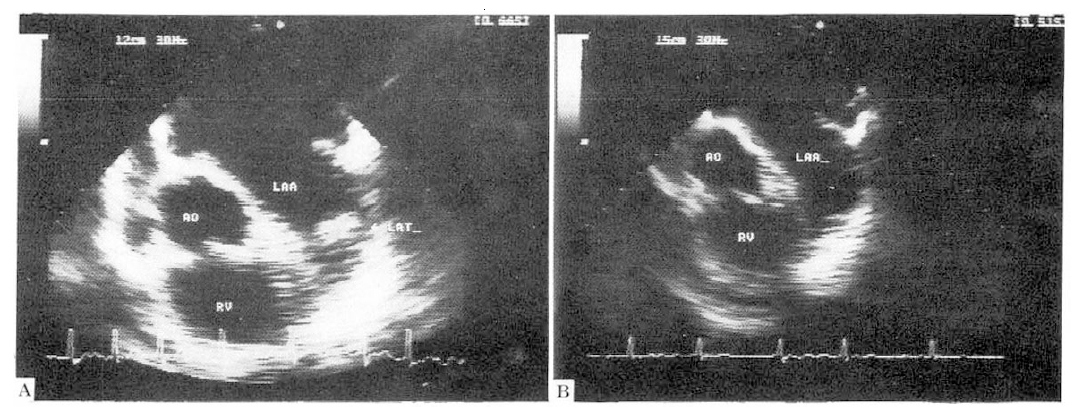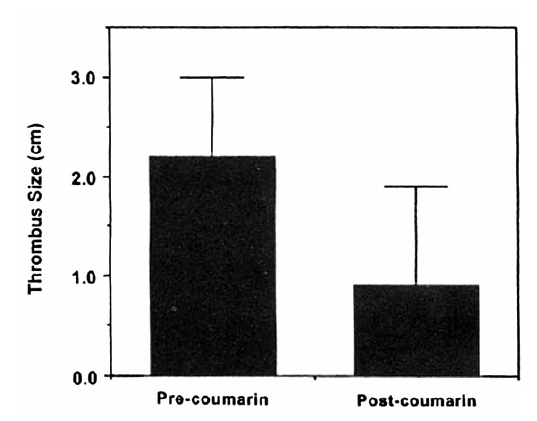INTRODUCTION
Left atrial thrombus (LAT) is a very important predisposing condition for systemic embolism. In most cases, atrial fibrillation is an underlying abnormality1,2). A number of randomized trials have demonstrated a significant reduction in thrombotic stroke by warfarin therapy in patients with atrial fibrillation3–7).
Since transesophageal echocardiography (TEE) was introduced, TEE was known to have high sensitivity and specificity for the detection of LAT8). In clinical practice, it is sometimes very difficult to know how to manage the patients with LAT who have minimal symptom or no structural heart disease. Anticoagulation may be the main therapeutic choice in a majority of these cases. But there has been no study about how LAT would evolve with anticoagulation. The authors performed follow-up TEE after anticoagulation in patients who showed LAT on TEE. The purposes of this study are 1) to show the evolutional change of LAT with anticoagulation and 2) to make the rationale for empirical therapy in these patients.
METHODS
1. Study Patients
Thirteen patients (male: 4, female:9) were included after LAT was detected by TEE. The underlying diseases were mitral valve diseases in 8 patients and combined mitral and aortic valve diseases in 2 patients. Three patients showed no structural heart diseases. Three patients had experienced cerebral embolism in the past. Eleven patients had atrial fibrillations. Two patients had normal sinus rhythms.
2. Transesophageal Echocardiography
After-midnight fasting, TEE was performed in the left lateral decubitus position. The oropharynx was anesthetized with lidocaine gurgling and spray. Biplane 5.0 MHz probe (Aloka, Japan) was used. All data was recorded on videotape for future playback. The data was interpreted by two experienced cardiologists. The size of LAT was measured by the longest length of the thrombus because LAT was sometimes of oval shape.
RESULTS
During follow-up period, the average dose of warfairn was 3.2 mg per day. In 9 patients, anticoagulation therapy was effective with adequate prolongation of prothrombin time (International Normalized Ratio; INR>2.0) (Group I), but 4 patients showed inadequate responses due to poor compliance (Group II). Systemic embolism developed in 2 patients in group II (50%), but no embolic event was noted in group I. In Group I, the average INR was 2.20±0.09.
At follow-up TEE, LAT disappeared in 3 patients in group I (33%) (Fig. 1) and in one patient in group II after systemic embolism. The size of LAT in group I was 2.2±0.8cm (mean±S.D.)at 1st TEE and LAT decreased significantly to the size of 0.9±1.0cm at 2nd TEE (Fig. 2, p<0.05 by paired Student’s t-test).
DISCUSSION
There have been a number of clinical studies regarding the efficacy of warfarin in reducing the future embolic events in patients with atrial fibrillation. But there was no direct demonstration of the decrease in size of, LAT with anticoagulation. To our knowledge, this seems to be the first report about the evolution of LAT with anticoagulation.
The efficacy of anticoagulation was very high in patients with adequate prolongation of prothrombin time with warfarin, and this supports the provious clinical observation of the beneficial effect of warfarin in preventing the systemic embolism. Also, the high incidence of systemic embolism, in patients with inadequate prolongation of prothrombin time, highlights the importance of anticoagulation in the prevention of systemic embolism. There has been much debate about the adequate level of anticoagulation in patients with atrial fibrillation9–12). In valvular heart disease, the adequate anticoagulation has been recommended as INR 3.0–4.5. But this level of anticoagulation increases the incidence of bleeding complication. From our data, adequate level of anticoagulation seems to be more than 2.0 in INR. This finding suppports the recommendation by the European Heart Journal13).
The mechanism of resolution in some cases seems to be the natural thrombolytic activity. The anticoagulation can promote the thrombolysis by preventing the thrombogenity. Systemic embolism cannot be ascribed completely to the presence of LAT because it develops in the absence of LAT. Spontaneous echo contrast (SEC) can be the predisposing factor to systemic embolism. But in our study population, patients with LAT were included without regard to the presence or absence of SEC.
In conclusion, this study demonstrated the effectiveness of oral anticoagulation not only in preventing the systemic embolism but also in decreasing the size of LAT in patients with LAT.





 PDF Links
PDF Links PubReader
PubReader ePub Link
ePub Link Full text via DOI
Full text via DOI Download Citation
Download Citation Print
Print





